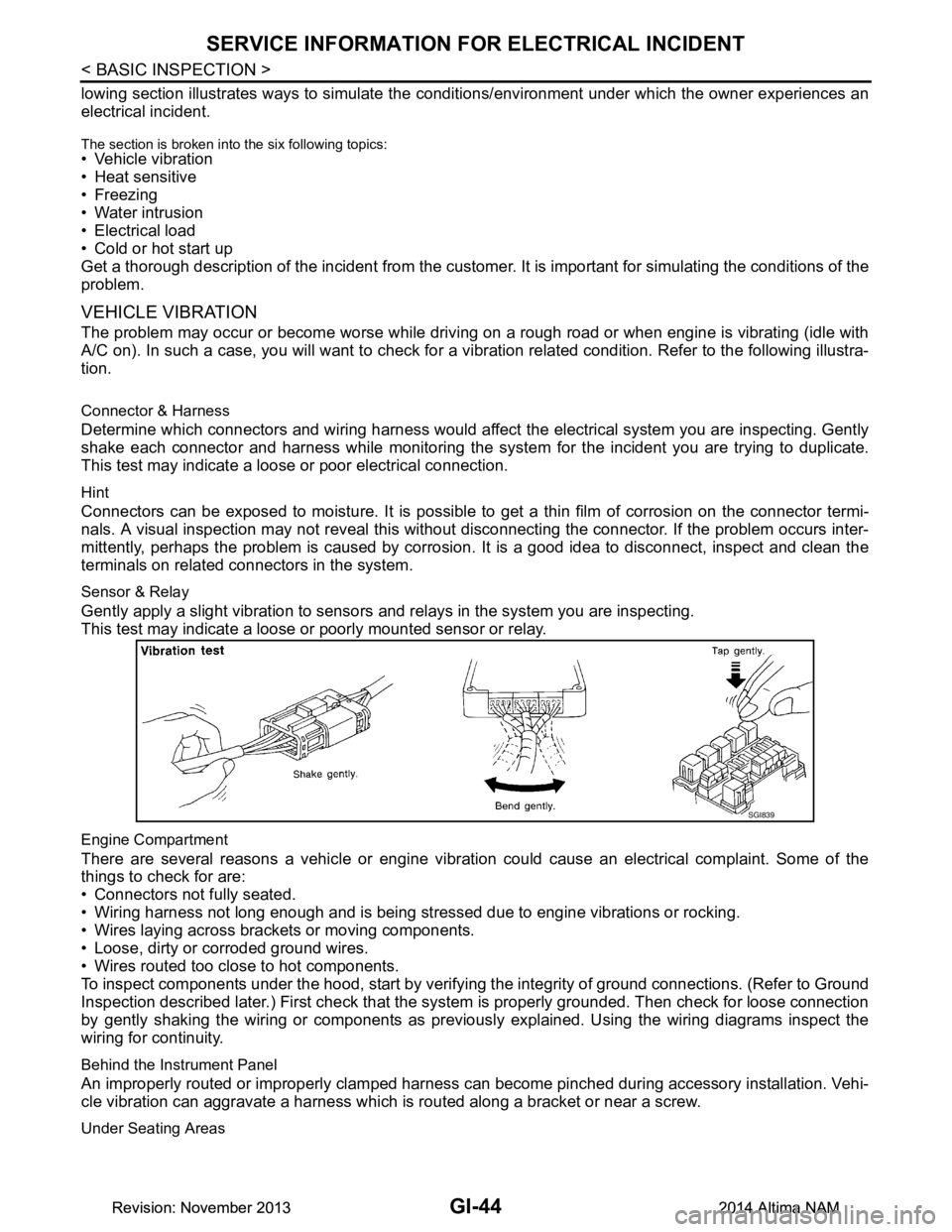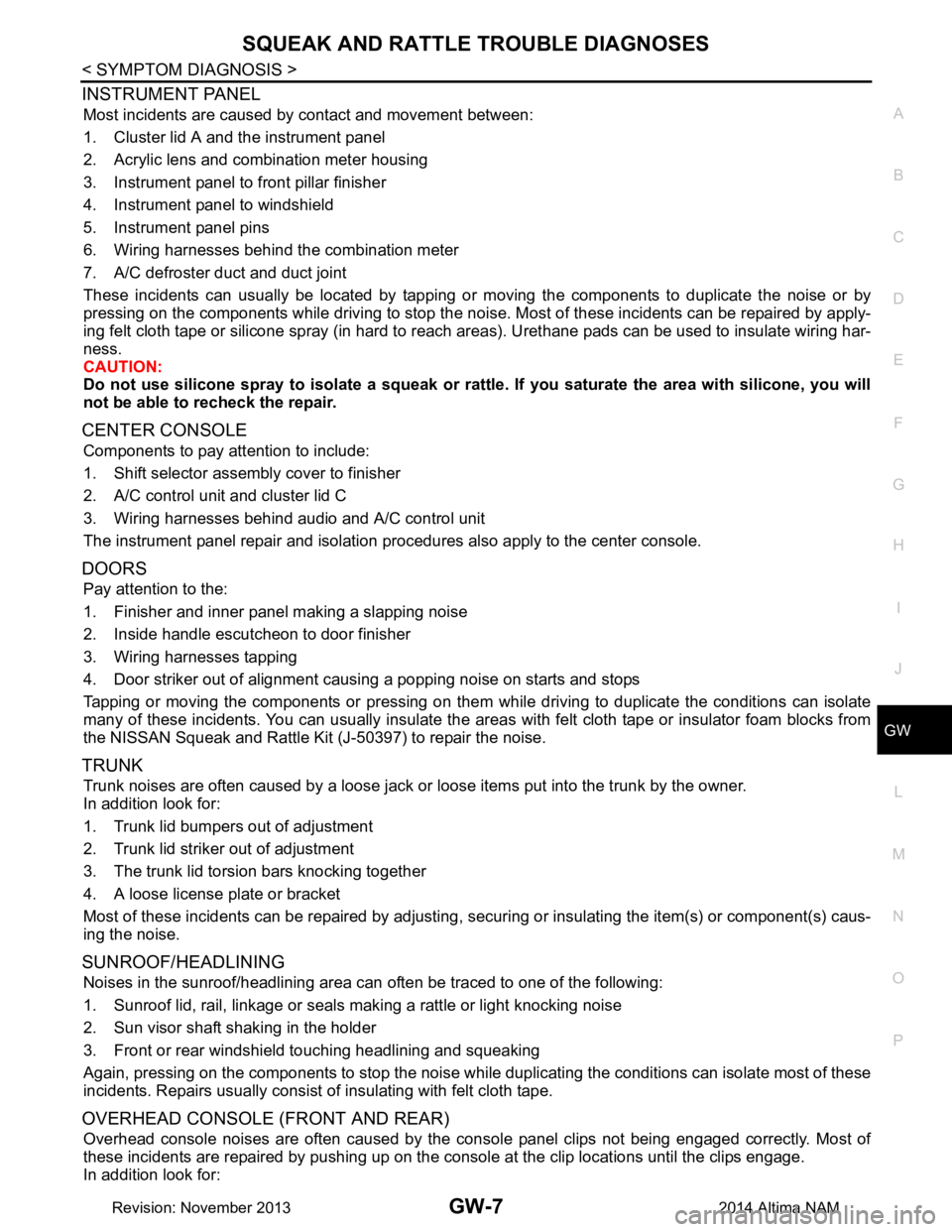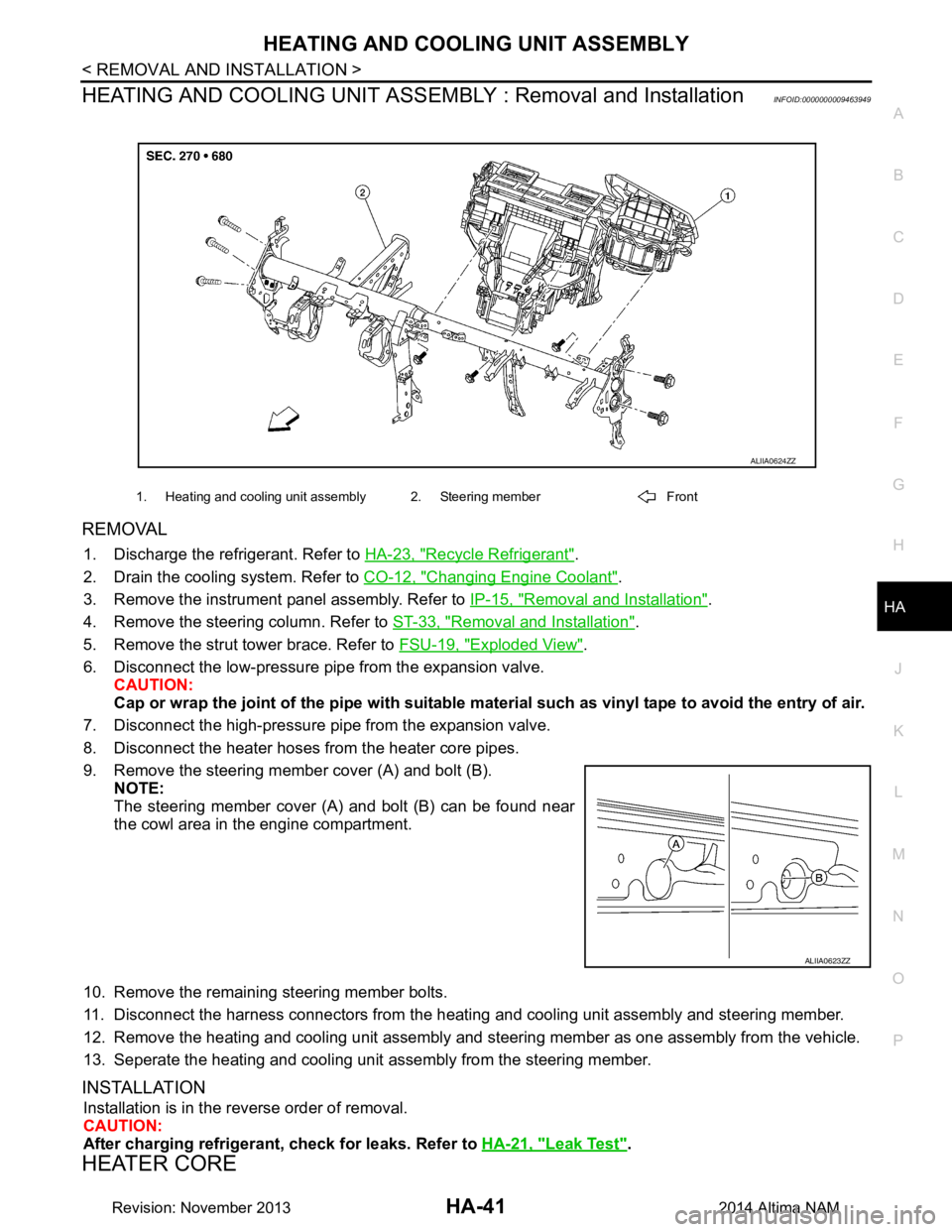2014 NISSAN TEANA instrument panel
[x] Cancel search: instrument panelPage 1598 of 4801
![NISSAN TEANA 2014 Service Manual
EC-598
< SYSTEM DESCRIPTION >[VQ35DE]
DIAGNOSIS SYSTEM (ECM)
PERMANENT DTC SET TIMING
The setting timing of permanent DTC is stored in EC
M with the lighting of MIL when a DTC is confirmed.
DIAGNOSIS NISSAN TEANA 2014 Service Manual
EC-598
< SYSTEM DESCRIPTION >[VQ35DE]
DIAGNOSIS SYSTEM (ECM)
PERMANENT DTC SET TIMING
The setting timing of permanent DTC is stored in EC
M with the lighting of MIL when a DTC is confirmed.
DIAGNOSIS](/manual-img/5/57390/w960_57390-1597.png)
EC-598
< SYSTEM DESCRIPTION >[VQ35DE]
DIAGNOSIS SYSTEM (ECM)
PERMANENT DTC SET TIMING
The setting timing of permanent DTC is stored in EC
M with the lighting of MIL when a DTC is confirmed.
DIAGNOSIS DESCRIPTION : Malfunction Indicator Lamp (MIL)INFOID:0000000009462539
• When detecting a DTC that affects exhaust gas, the exhaust emis-
sion-related control module transmits a malfunction indicator lamp
signal to ECM via CAN communication line.
ECM prioritizes (MIL: ON/blink) the signal received from the
exhaust emission-related control module and the ECM-stored DTC
that affects exhaust gas and transmits a malfunction indicator lamp
signal to the combination meter via CAN communication line.
The combination meter turns ON or blinks the MIL, according to
the signal transmitted from ECM, and alerts the driver of malfunc-
tion detection.
• Control modules that a DTC of MIL ON/Blink is stored (Control module varies among DTCs.):
-ECM
-TCM
1. The MIL illuminates when ignition switch is turned ON (engine is not running). NOTE:
Check the MIL circuit if MIL does not illuminate. Refer to EC-973, "Component Function Check"
.
2. When the engine is started, the MIL should go off. NOTE:
If MIL remains ON or continues blinking, a DTC(s) t hat affects exhaust gas is detected. In this case, Self
diagnosis is required for performing inspection and repair.
On Board Diagn osis FunctionINFOID:0000000009462540
ON BOARD DIAGNOSIS ITEM
The on board diagnostic system has the following functions.
BULB CHECK MODE
Description
This function allows damage inspection in the MIL bulb (blown, open circuit, etc.).
Operation Procedure
1. Turn ignition switch ON.
2. The MIL on the instrument panel should stay ON.
If it remains OFF, check MIL circuit. Refer to EC-973, "Diagnosis Procedure"
.
SRT STATUS MODE
Description
JSBIA1315ZZ
Diagnostic test mode Function
Bulb check MIL can be checked.
SRT status ECM can read if SRT codes are set.
Malfunction warning If ECM detects a malfunction, it illuminates or blinks MIL to inform the driver that a malfunction has been detected.
Self-diagnostic results DTCs or 1st trip DTCs stored in ECM can be read.
Accelerator pedal released po-
sition learning ECM can learn the accelerator pedal released position. Refer to
EC-681, "Description"
.
Throttle valve closed position
learning ECM can learn the throttle valve closed position. Refer to
EC-682, "Description"
.
Idle air volume learning ECM can learn the idle air volume. Refer to EC-683, "Description"
.
Mixture ratio self -learning value
clear Mixture ratio self-learning value can be erased. Refer to
EC-685, "Description"
.
Revision: November 20132014 Altima NAMRevision: November 20132014 Altima NAM
Page 2426 of 4801

EXT-12
< PERIODIC MAINTENANCE >
SQUEAK AND RATTLE TROUBLE DIAGNOSES
INSTRUMENT PANEL
Most incidents are caused by contact and movement between:
1. Cluster lid A and the instrument panel
2. Acrylic lens and combination meter housing
3. Instrument panel to front pillar finisher
4. Instrument panel to windshield
5. Instrument panel pins
6. Wiring harnesses behind the combination meter
7. A/C defroster duct and duct joint
These incidents can usually be located by tapping or moving the components to duplicate the noise or by
pressing on the components while driving to stop the noise. Most of these incidents can be repaired by apply-
ing felt cloth tape or silicone spray (in hard to reach areas). Urethane pads can be used to insulate wiring har-
ness.
CAUTION:
Do not use silicone spray to isolate a squeak or ra ttle. If you saturate the area with silicone, you will
not be able to recheck the repair.
CENTER CONSOLE
Components to pay attention to include:
1. Shift selector assembly cover to finisher
2. A/C control unit and cluster lid C
3. Wiring harnesses behind audio and A/C control unit
The instrument panel repair and isolation pr ocedures also apply to the center console.
DOORS
Pay attention to the:
1. Finisher and inner panel making a slapping noise
2. Inside handle escutcheon to door finisher
3. Wiring harnesses tapping
4. Door striker out of alignment causing a popping noise on starts and stops
Tapping or moving the components or pressing on them wh ile driving to duplicate the conditions can isolate
many of these incidents. You can usually insulate the areas with felt cloth tape or insulator foam blocks from
the NISSAN Squeak and Rattle Kit (J-50397) to repair the noise.
TRUNK
Trunk noises are often caused by a loose jack or loose items put into the trunk by the owner.
In addition look for:
1. Trunk lid bumpers out of adjustment
2. Trunk lid striker out of adjustment
3. The trunk lid torsion bars knocking together
4. A loose license plate or bracket
Most of these incidents can be repaired by adjusting, se curing or insulating the item(s) or component(s) caus-
ing the noise.
SUNROOF/HEADLINING
Noises in the sunroof/headlining area c an often be traced to one of the following:
1. Sunroof lid, rail, linkage or seals making a rattle or light knocking noise
2. Sun visor shaft shaking in the holder
3. Front or rear windshield touching headlining and squeaking
Again, pressing on the components to stop the noise while duplicating the conditions can isolate most of these
incidents. Repairs usually consist of insulating with felt cloth tape.
OVERHEAD CONSOLE (FRONT AND REAR)
Overhead console noises are often caused by the c onsole panel clips not being engaged correctly. Most of
these incidents are repaired by pushing up on the c onsole at the clip locations until the clips engage.
In addition look for:
Revision: November 20132014 Altima NAM
Page 2572 of 4801

GI-44
< BASIC INSPECTION >
SERVICE INFORMATION FOR ELECTRICAL INCIDENT
lowing section illustrates ways to simulate the conditions/environment under which the owner experiences an
electrical incident.
The section is broken into the six following topics:• Vehicle vibration
• Heat sensitive
• Freezing
• Water intrusion
• Electrical load
• Cold or hot start up
Get a thorough description of the incident from the customer . It is important for simulating the conditions of the
problem.
VEHICLE VIBRATION
The problem may occur or become worse while driving on a rough road or when engine is vibrating (idle with
A/C on). In such a case, you will want to check for a vi bration related condition. Refer to the following illustra-
tion.
Connector & Harness
Determine which connectors and wiring harness would affect the electrical system you are inspecting. Gently
shake each connector and harness while monitoring the sy stem for the incident you are trying to duplicate.
This test may indicate a loose or poor electrical connection.
Hint
Connectors can be exposed to moisture. It is possible to get a thin film of corrosion on the connector termi-
nals. A visual inspection may not reveal this without disconnecting the connector. If the problem occurs inter-
mittently, perhaps the problem is caused by corrosion. It is a good idea to disconnect, inspect and clean the
terminals on related connectors in the system.
Sensor & Relay
Gently apply a slight vibration to sensors and relays in the system you are inspecting.
This test may indicate a loose or poorly mounted sensor or relay.
Engine Compartment
There are several reasons a vehicle or engine vibration could cause an electrical complaint. Some of the
things to check for are:
• Connectors not fully seated.
• Wiring harness not long enough and is being stressed due to engine vibrations or rocking.
• Wires laying across brackets or moving components.
• Loose, dirty or corroded ground wires.
• Wires routed too close to hot components.
To inspect components under the hood, start by verifyi ng the integrity of ground connections. (Refer to Ground
Inspection described later.) First check that the system is properly grounded. Then check for loose connection
by gently shaking the wiring or components as previous ly explained. Using the wiring diagrams inspect the
wiring for continuity.
Behind the Instrument Panel
An improperly routed or improperly clamped harness can become pinched during accessory installation. Vehi-
cle vibration can aggravate a harness which is routed along a bracket or near a screw.
Under Seating Areas
SGI839
Revision: November 20132014 Altima NAMRevision: November 20132014 Altima NAM
Page 2587 of 4801

SQUEAK AND RATTLE TROUBLE DIAGNOSESGW-7
< SYMPTOM DIAGNOSIS >
C
D E
F
G H
I
J
L
M A
B
GW
N
O P
INSTRUMENT PANEL
Most incidents are caused by contact and movement between:
1. Cluster lid A and the instrument panel
2. Acrylic lens and combination meter housing
3. Instrument panel to front pillar finisher
4. Instrument panel to windshield
5. Instrument panel pins
6. Wiring harnesses behind the combination meter
7. A/C defroster duct and duct joint
These incidents can usually be located by tapping or moving the components to duplicate the noise or by
pressing on the components while driving to stop the noi se. Most of these incidents can be repaired by apply-
ing felt cloth tape or silicone spray (in hard to reach areas). Urethane pads can be used to insulate wiring har-
ness.
CAUTION:
Do not use silicone spray to isolate a squeak or ra ttle. If you saturate the area with silicone, you will
not be able to recheck the repair.
CENTER CONSOLE
Components to pay attention to include:
1. Shift selector assembly cover to finisher
2. A/C control unit and cluster lid C
3. Wiring harnesses behind audio and A/C control unit
The instrument panel repair and isolation pr ocedures also apply to the center console.
DOORS
Pay attention to the:
1. Finisher and inner panel making a slapping noise
2. Inside handle escutcheon to door finisher
3. Wiring harnesses tapping
4. Door striker out of alignment causing a popping noise on starts and stops
Tapping or moving the components or pressing on them wh ile driving to duplicate the conditions can isolate
many of these incidents. You can usually insulate the ar eas with felt cloth tape or insulator foam blocks from
the NISSAN Squeak and Rattle Kit (J-50397) to repair the noise.
TRUNK
Trunk noises are often caused by a loose jack or loose items put into the trunk by the owner.
In addition look for:
1. Trunk lid bumpers out of adjustment
2. Trunk lid striker out of adjustment
3. The trunk lid torsion bars knocking together
4. A loose license plate or bracket
Most of these incidents can be repaired by adjusting, se curing or insulating the item(s) or component(s) caus-
ing the noise.
SUNROOF/HEADLINING
Noises in the sunroof/headlining area can often be traced to one of the following:
1. Sunroof lid, rail, linkage or seals making a rattle or light knocking noise
2. Sun visor shaft shaking in the holder
3. Front or rear windshield touching headlining and squeaking
Again, pressing on the components to stop the noise while duplicating the conditions can isolate most of these
incidents. Repairs usually consist of insulating with felt cloth tape.
OVERHEAD CONSOLE (FRONT AND REAR)
Overhead console noises are often caused by the cons ole panel clips not being engaged correctly. Most of
these incidents are repaired by pushing up on the c onsole at the clip locations until the clips engage.
In addition look for:
Revision: November 20132014 Altima NAM
Page 2647 of 4801

HEATING AND COOLING UNIT ASSEMBLYHA-41
< REMOVAL AND INSTALLATION >
C
D E
F
G H
J
K L
M A
B
HA
N
O P
HEATING AND COOLING UNIT ASSEMB LY : Removal and InstallationINFOID:0000000009463949
REMOVAL
1. Discharge the refrigerant. Refer to HA-23, "Recycle Refrigerant".
2. Drain the cooling system. Refer to CO-12, "Changing Engine Coolant"
.
3. Remove the instrument panel assembly. Refer to IP-15, "Removal and Installation"
.
4. Remove the steering column. Refer to ST-33, "Removal and Installation"
.
5. Remove the strut tower brace. Refer to FSU-19, "Exploded View"
.
6. Disconnect the low-pressure pipe from the expansion valve. CAUTION:
Cap or wrap the joint of the pipe with suitable ma terial such as vinyl tape to avoid the entry of air.
7. Disconnect the high-pressure pi pe from the expansion valve.
8. Disconnect the heater hoses from the heater core pipes.
9. Remove the steering member cover (A) and bolt (B). NOTE:
The steering member cover (A) and bolt (B) can be found near
the cowl area in the engine compartment.
10. Remove the remaining steering member bolts.
11. Disconnect the harness connectors from the heati ng and cooling unit assembly and steering member.
12. Remove the heating and cooling unit assembly and steering member as one assembly from the vehicle.
13. Seperate the heating and cooling unit assembly from the steering member.
INSTALLATION
Installation is in the reverse order of removal.
CAUTION:
After charging refrigerant, check for leaks. Refer to HA-21, "Leak Test"
.
HEATER CORE
1. Heating and cooling unit assembly 2. Steering member Front
ALIIA0624ZZ
ALIIA0623ZZ
Revision: November 20132014 Altima NAM
Page 2753 of 4801
![NISSAN TEANA 2014 Service Manual
HAC-104
< REMOVAL AND INSTALLATION >[AUTOMATIC AIR CONDITIONER]
IN-VEHICLE SENSOR
IN-VEHICLE SENSOR
Removal and InstallationINFOID:0000000009463177
REMOVAL
1. Remove the instrument lower panel LH. Re NISSAN TEANA 2014 Service Manual
HAC-104
< REMOVAL AND INSTALLATION >[AUTOMATIC AIR CONDITIONER]
IN-VEHICLE SENSOR
IN-VEHICLE SENSOR
Removal and InstallationINFOID:0000000009463177
REMOVAL
1. Remove the instrument lower panel LH. Re](/manual-img/5/57390/w960_57390-2752.png)
HAC-104
< REMOVAL AND INSTALLATION >[AUTOMATIC AIR CONDITIONER]
IN-VEHICLE SENSOR
IN-VEHICLE SENSOR
Removal and InstallationINFOID:0000000009463177
REMOVAL
1. Remove the instrument lower panel LH. Refer to
IP-21, "Removal and Installation".
2. Disconnect the harness connector from the in-vehicle sensor.
3. Disconnect the aspirator hose (2) from the in-vehicle sensor.
4. Remove the in-vehicle sensor screw (A) and the in-vehicle sen- sor (1).
INSTALLATION
Installation is in the reverse order of removal.
ALIIA0593ZZ
Revision: November 20132014 Altima NAMRevision: November 20132014 Altima NAM
Page 2758 of 4801
![NISSAN TEANA 2014 Service Manual
DOOR MOTORHAC-109
< REMOVAL AND INSTALLATION > [AUTOMATIC AIR CONDITIONER]
C
D E
F
G H
J
K L
M A
B
HAC
N
O P
INTAKE DOOR MOTOR
INTAKE DOOR MOTOR : Re moval and InstallationINFOID:0000000009463182
R NISSAN TEANA 2014 Service Manual
DOOR MOTORHAC-109
< REMOVAL AND INSTALLATION > [AUTOMATIC AIR CONDITIONER]
C
D E
F
G H
J
K L
M A
B
HAC
N
O P
INTAKE DOOR MOTOR
INTAKE DOOR MOTOR : Re moval and InstallationINFOID:0000000009463182
R](/manual-img/5/57390/w960_57390-2757.png)
DOOR MOTORHAC-109
< REMOVAL AND INSTALLATION > [AUTOMATIC AIR CONDITIONER]
C
D E
F
G H
J
K L
M A
B
HAC
N
O P
INTAKE DOOR MOTOR
INTAKE DOOR MOTOR : Re moval and InstallationINFOID:0000000009463182
REMOVAL
1. Remove the glove box assembly. Refer to IP-22, "Removal and Installation".
2. Disconnect the harness connector from the intake door motor.
3. Remove the intake door motor screws and the intake door motor.
INSTALLATION
Installation is in the reverse order of removal.
MODE DOOR MOTOR
MODE DOOR MOTOR : Re moval and InstallationINFOID:0000000009463183
REMOVAL
1. Remove the instrument lower panel LH. Refer to IP-21, "Removal and Installation".
2. Disconnect the harness connector from the mode door motor.
3. Remove the mode door motor screws and the mode door motor.
INSTALLATION
Installation is in the reverse order of removal.
AIR MIX DOOR MOTOR
AIR MIX DOOR MOTOR : Removal and Inst allation - Air Mix Door Motor (RH)
INFOID:0000000009463184
REMOVAL
1. Remove the glove box assembly. Refer to IP-22, "Removal and Installation".
2. Remove the upper floor connecting duct (RH). Refer to HA-40, "Exploded View"
.
3. Disconnect the harness connector from the air mix door motor (RH).
4. Remove the air mix door motor (RH) screws and the air mix door motor (RH).
INSTALLATION
Installation is in the reverse order of removal.
AIR MIX DOOR MOTOR : Removal and Inst allation - Air Mix Door Motor (LH)
INFOID:0000000009463185
REMOVAL
1. Remove the upper floor connecting duct (LH). Refer to HA-40, "Exploded View".
2. Disconnect the harness connector from the air mix door motor (LH).
3. Remove the air mix door motor (LH) screws and the air mix door motor (LH).
INSTALLATION
Installation is in the reverse order of removal.
Revision: November 20132014 Altima NAMRevision: November 20132014 Altima NAM
Page 2811 of 4801
![NISSAN TEANA 2014 Service Manual
HAC-162
< REMOVAL AND INSTALLATION >[MANUAL AIR CONDITIONER]
IN-VEHICLE SENSOR
IN-VEHICLE SENSOR
Removal and InstallationINFOID:0000000009463228
REMOVAL
1. Remove the instrument lower panel LH. Refer NISSAN TEANA 2014 Service Manual
HAC-162
< REMOVAL AND INSTALLATION >[MANUAL AIR CONDITIONER]
IN-VEHICLE SENSOR
IN-VEHICLE SENSOR
Removal and InstallationINFOID:0000000009463228
REMOVAL
1. Remove the instrument lower panel LH. Refer](/manual-img/5/57390/w960_57390-2810.png)
HAC-162
< REMOVAL AND INSTALLATION >[MANUAL AIR CONDITIONER]
IN-VEHICLE SENSOR
IN-VEHICLE SENSOR
Removal and InstallationINFOID:0000000009463228
REMOVAL
1. Remove the instrument lower panel LH. Refer to
IP-21, "Removal and Installation".
2. Disconnect the harness connector from the in-vehicle sensor.
3. Disconnect the aspirator hose (2) from the in-vehicle sensor.
4. Remove the in-vehicle sensor screw (A) and the in-vehicle sen- sor (1).
INSTALLATION
Installation is in the reverse order of removal.
ALIIA0593ZZ
Revision: November 20132014 Altima NAMRevision: November 20132014 Altima NAM